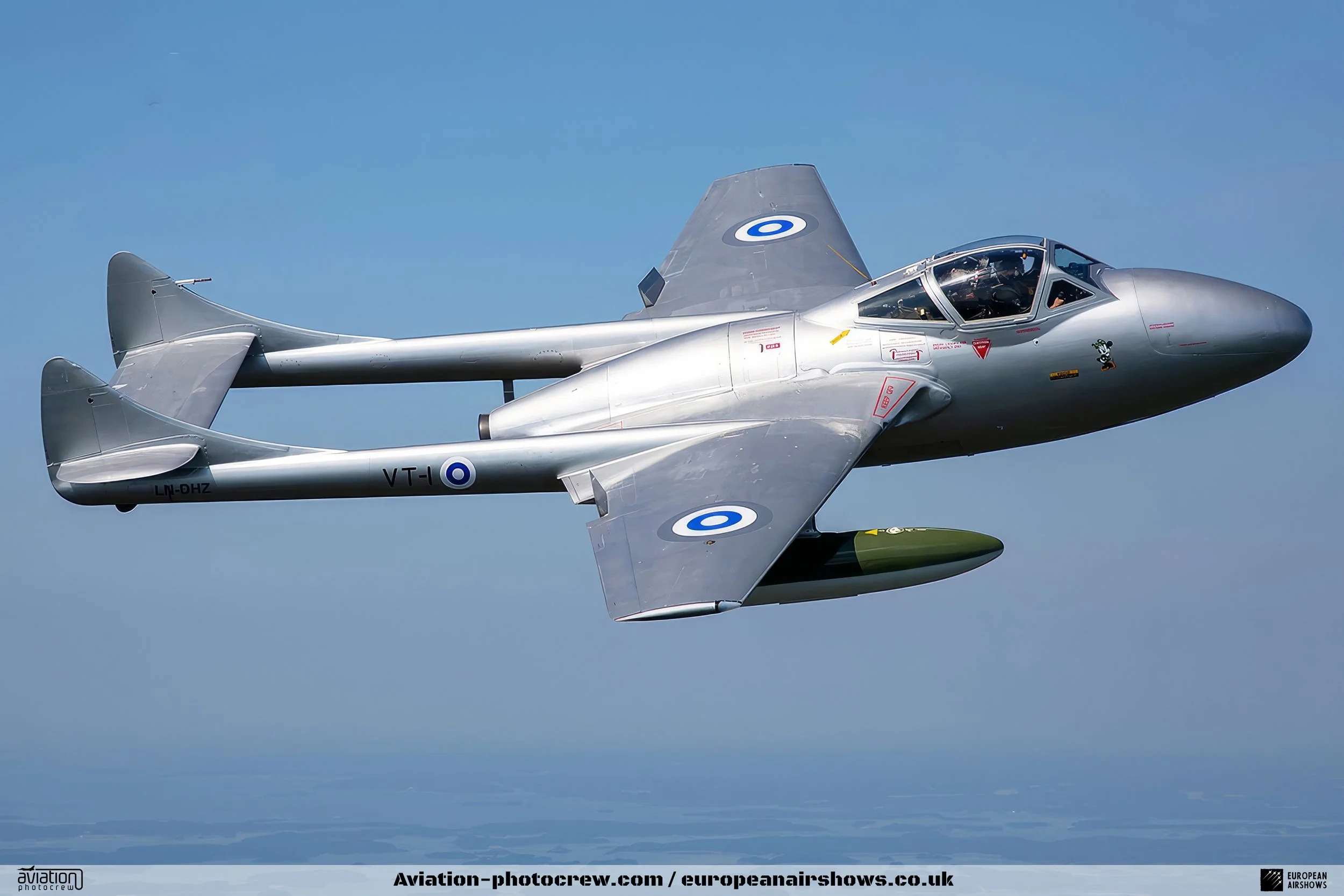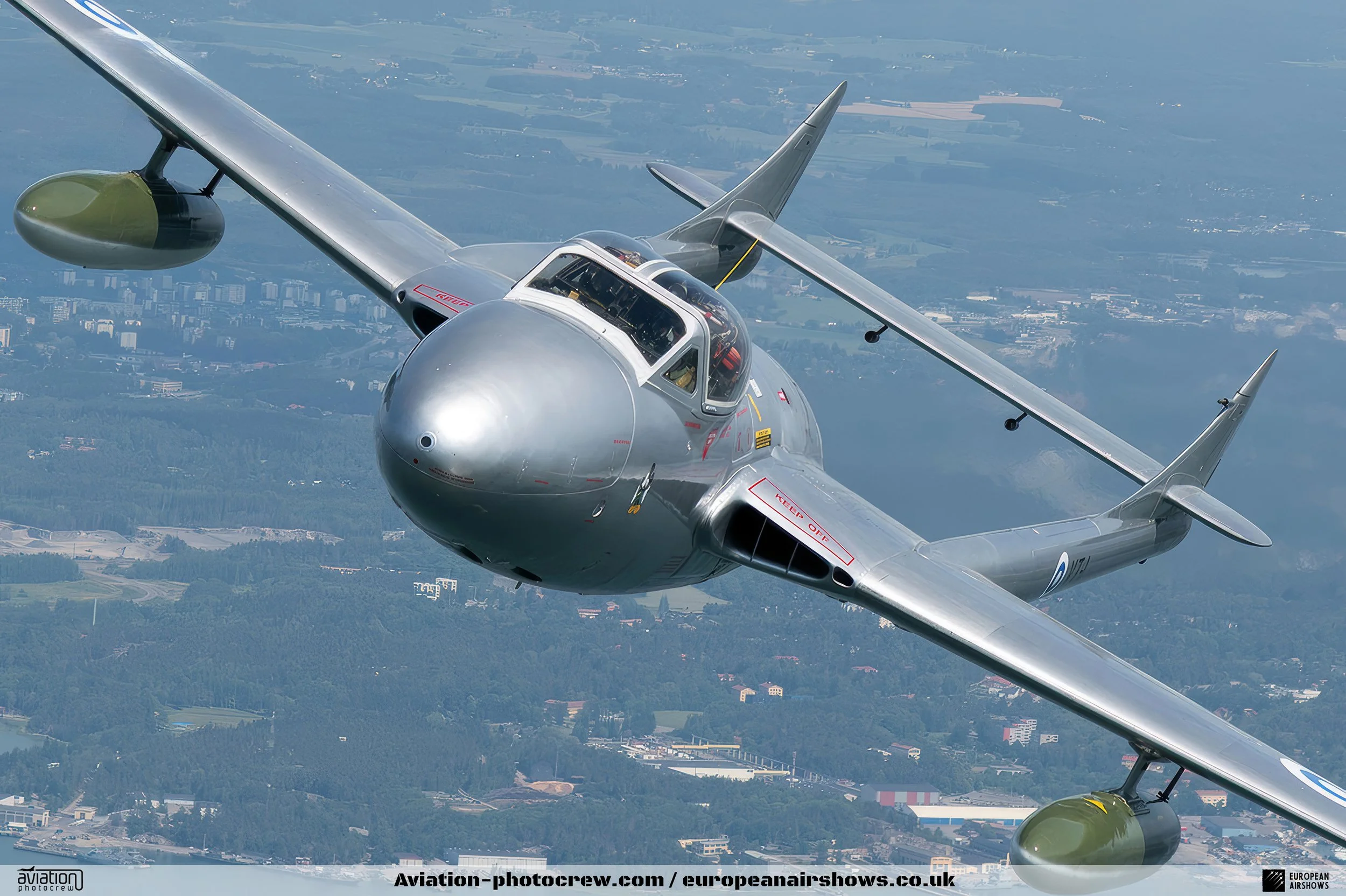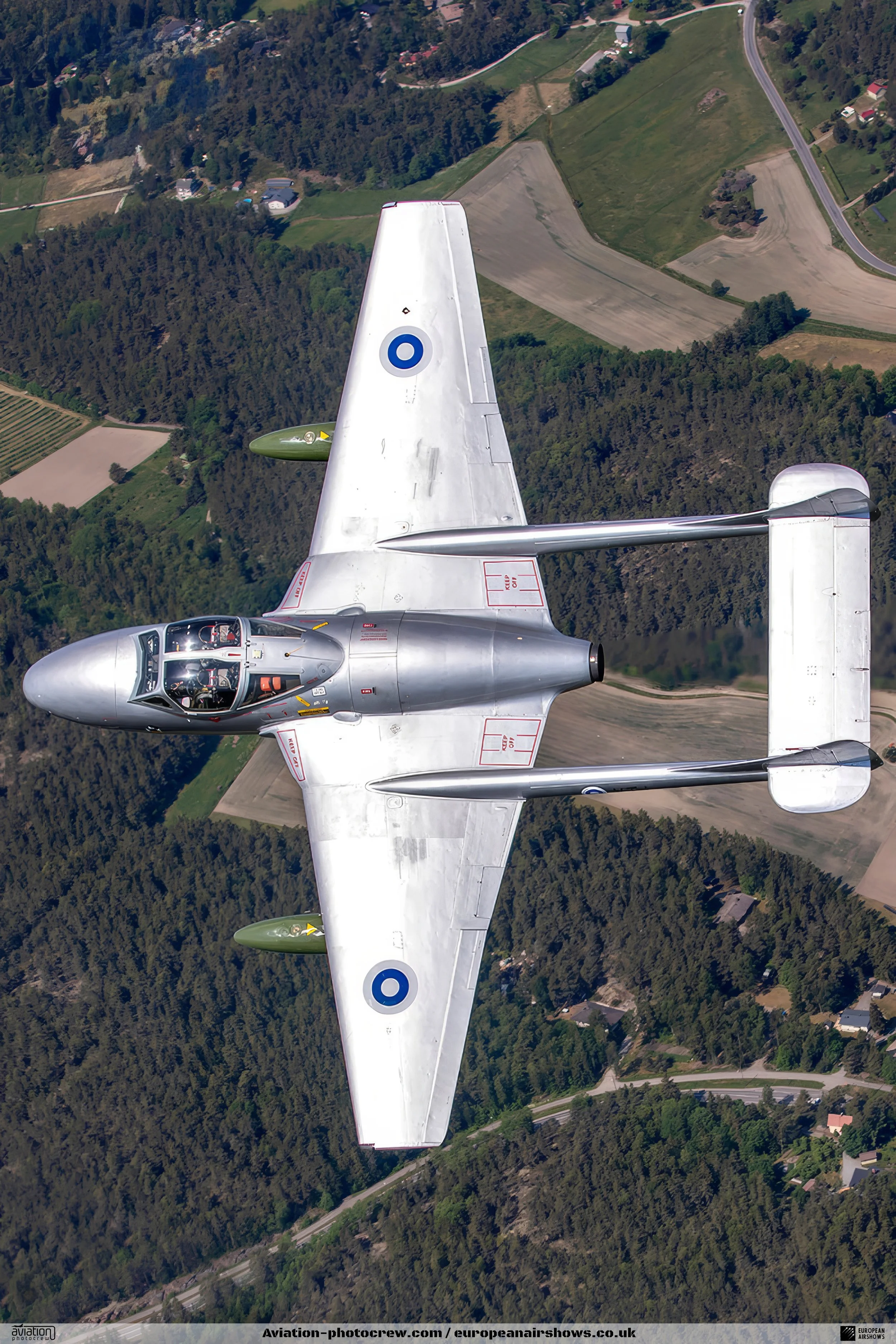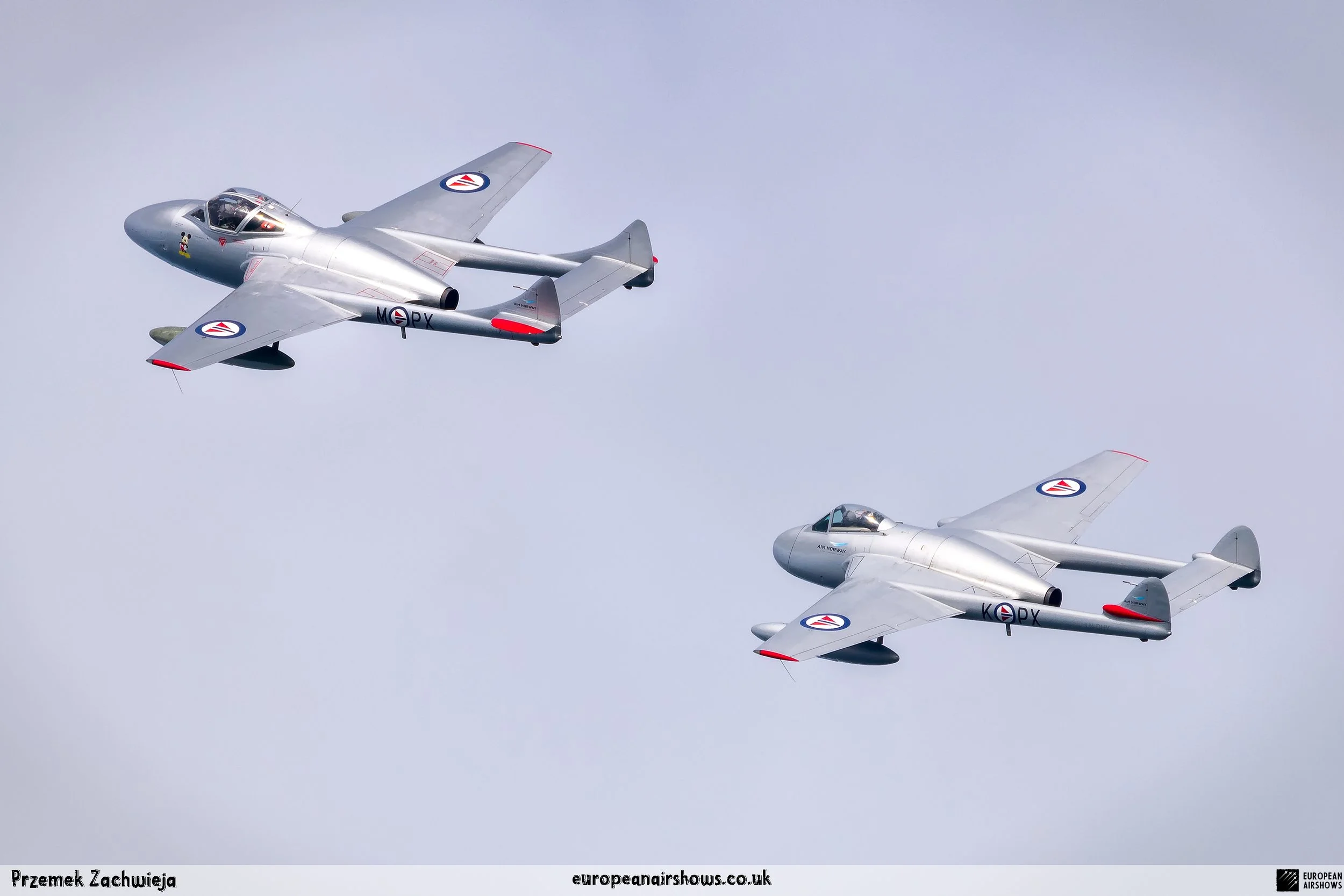
de Havilland Vampire LN-DHZ
About the Aircraft
The de Havilland DH100 Vampire, introduced in the mid-1940s, was one of the United Kingdom’s first jet fighters and the RAF’s second operational jet aircraft after the Gloster Meteor. Conceived in 1941 during World War II, the Vampire was designed to exploit the emerging technology of jet propulsion, utilizing a single Halford H.1 (later Goblin) turbojet engine housed within a distinctive twin-boom configuration. Its development was spearheaded by the de Havilland Aircraft Company, which leveraged its expertise in both wood and metal aircraft construction. The Vampire made its maiden flight on September 20, 1943, and entered service with the Royal Air Force in 1946, swiftly replacing many piston-engined fighters due to its superior speed and performance. The aircraft set several aviation milestones, including being the first jet to cross the Atlantic Ocean and the first pure-jet aircraft to operate from an aircraft carrier.
Throughout its operational history, the Vampire proved to be a versatile and reliable platform, adapted into numerous variants to fulfill roles ranging from interceptor and ground-attack missions to advanced pilot training. Its adaptability facilitated widespread export, with nearly 3,300 units manufactured and serving in 31 air forces worldwide. Notable versions included the Sea Vampire for naval operations, the FB.5 fighter-bomber, and the DH.115 Vampire trainer. The Vampire saw combat in various conflicts such as the Suez Crisis, the Malayan Emergency, and the Rhodesian Bush War, demonstrating its effectiveness in diverse environments. Production continued until the mid-1960s, when advancements in jet technology and the introduction of more sophisticated aircraft led to its retirement. The Vampire’s enduring legacy lies in its role in transitioning air forces from piston-engined fighters to the jet age, cementing its place as a significant milestone in military aviation history.
Specifications
Crew
1 or 2
Length
30 ft 9 in (9.37 m)
Wingspan
38 ft (11.58 m)
Height
8 ft 10 in (2.69 m)
Max Speed
548 mph (882 km/h, 476 kn)
Range
1,220 mi (1,960 km, 1,060 nmi)
Service Ceiling
42,800 ft (13,000 m)
g limits
+6 to -3
Vampire T.55
The de Havilland DH100 Vampire, a pioneering British jet fighter developed during World War II, holds the distinction of being the Royal Air Force’s (RAF) second operational jet fighter, following the Gloster Meteor. Conceived in 1941 under the guidance of Sir Henry Tizard, the Vampire was designed to harness the emerging technology of jet propulsion. Utilizing a single Halford H.1 turbojet engine and featuring a distinctive twin-boom configuration, the aircraft made its maiden flight on September 20, 1943. The Vampire rapidly proved its efficacy, setting several aviation firsts, including being the first jet aircraft to cross the Atlantic Ocean, and was officially inducted into RAF service in 1946. Its straightforward design, reliability, and superior performance allowed it to replace numerous piston-engined fighters in front-line service, remaining a versatile asset until its transition to secondary roles in the early 1950s.
Among the various iterations of the Vampire, the T.55 emerged as a significant trainer variant tailored for export markets. The T.55 was developed by converting existing Vampire trainers, such as the T.11, and constructing new units specifically for international customers. A total of 322 T.55s were produced, with notable production runs in Switzerland and India, where Hindustan Aeronautics Limited (HAL) manufactured 60 units. This variant was designed to provide advanced training capabilities, incorporating dual controls to accommodate both instructors and trainee pilots. Additionally, a small number of T.55s were modified for photo reconnaissance purposes (PR.55), demonstrating the versatility of the Vampire platform in fulfilling various operational requirements beyond its original fighter and ground-attack roles.
The Vampire T.55 served with numerous air forces worldwide, reflecting the aircraft’s widespread export and adaptability to diverse operational environments. Countries such as Switzerland and India utilized the T.55 extensively for pilot training, benefiting from its reliable performance and manageable handling characteristics. The T.55 played a crucial role in developing the next generation of jet pilots during the early years of jet aviation, bridging the transition from piston-engined aircraft to more advanced jet fighters. The longevity of the T.55 in service, with production continuing until the mid-1960s, underscored its effectiveness and the enduring legacy of the Vampire series in shaping post-war military aviation training programs globally.
Did You Know?
- The DH.100 Vampire was a versatile aircraft, serving as both a single-seat day fighter and a fighter-bomber, showcasing its adaptability to various military roles.
- Among the Vampire variants, the F.1 was the primary single-seat fighter version for the RAF, with 228 production aircraft built. Notably, 30 of these were later transferred to the French Air Force for familiarization.
- The FB.5 variant of the Vampire was particularly prolific, with 1,123 units constructed, including a significant number for the RAF. This model featured clipped wings and was specifically designed as a fighter-bomber.
- The Vampire’s design extended beyond the UK, with notable exports including 310 units of the FB.6 to Sweden, known as the J 28B, which were later relegated to an attack role.
- The NF.10 Vampire was a two-seat night fighter version, with 81 units built for the RAF. It was later exported, with countries like Italy and India acquiring refurbished models for their air forces.
Test Your Knowledge
Performer Information
The de Havilland Vampire T.55, bearing the registration LN-DHZ, has a rich and varied history that reflects the evolution of military aviation in Europe during the mid-20th century. This particular aircraft was license-built in Switzerland by F+W in Emmen in 1959, where it was designated as serial number 990. It was part of a production run that saw a total of 20 new two-seat Vampires constructed in Switzerland, making it a significant addition to the Swiss Air Force’s capabilities.
Initially, the Vampire T.55 served the Swiss Air Force under the designation U-1230, where it remained operational until 1990. Following its decommissioning, the aircraft was sold at auction in 1991 to Don Wood of Source Classic Flight, based in Bournemouth, UK. This marked the beginning of a new chapter in the Vampire’s life, as it transitioned from military service to civilian ownership.
In 2005, the aircraft was purchased from Bournemouth and has since been operated by the Norwegian Historical Squadron. The aircraft is now based at Rygge Air Base, located near Oslo in southern Norway. Throughout its operational history, the Vampire T.55 has undergone various transformations in terms of its color schemes, reflecting the different air forces it has been associated with. From its original Swiss Air Force markings, the aircraft has donned the liveries of the Royal Air Force (RAF) and the Finnish Air Force.
Currently, the Vampire T.55 is painted in the markings of the Royal Norwegian Air Force, specifically representing the Vampire PX-M, a two-seater that served with the 336 Squadron during the early 1950s. This squadron holds historical significance as Norway’s first pure jet fighter squadron. The aircraft’s association with the RNoAF extends to its time with various squadrons, including 336, 337, and 718 Squadrons, further embedding it in the legacy of Norwegian military aviation. Through its multiple roles and transformations, the de Havilland Vampire T.55 LN-DHZ continues to be a testament to the enduring legacy of jet-powered flight in the post-war era.







